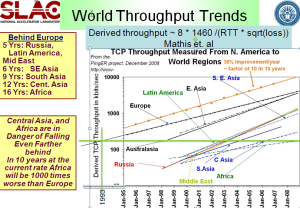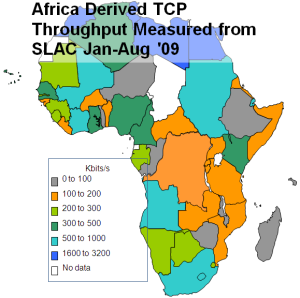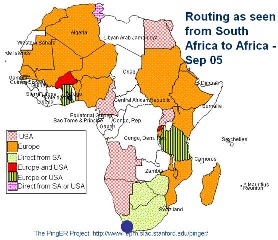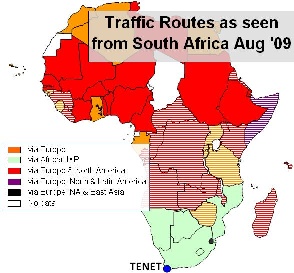...
<ac:structured-macro ac:name="unmigrated-wiki-markup" ac:schema-version="1" ac:macro-id="87c9a80484ae98ac-5d4c9443-420d4c8e-bceba90b-65916e709d409104a5b1aa39"><ac:plain-text-body><![CDATA[ | Throughput from SLAC to Regions of the World | Derived Throughput from SLAC to Africa Jan-Aug '09 [[xlsx | ^africa-thru-aug09.xlsx]] | MinRTT from SLAC - Aug. 2009 [[xls | ^map-africa-minrtt-aug2009.xls]] | ]]></ac:plain-text-body></ac:structured-macro> |
|---|---|---|---|---|---|---|
|
|
|
...
<ac:structured-macro ac:name="unmigrated-wiki-markup" ac:schema-version="1" ac:macro-id="5e519dafc6f795b3-9413bceb-4ab24001-b8e39f3f-70c0c91912872489519cf1eb"><ac:plain-text-body><![CDATA[ | Routing from South Africa to African Countries (Sep '05) | Routing from South Africa to African Countries (Aug '09) [[xls | ^routing-africa-aug2009.xls]] | Routing from Burkina Faso to African Countries (Aug '09) [[xls | ^routing-africa-aug2009.xls]] | ]]></ac:plain-text-body></ac:structured-macro> |
|---|---|---|---|---|---|---|
| |
|
...
On Aug 2, 2009 following an email from Don Riley who had detected that kdn.co.ke had dropped to 370ms. We were Unfortunately not monitoring kdn.co.ke. However on further investigation we found the RTT from SLAC to acheraarchitects.co.ke (see below) had changed between 14:00 and 17:00 hours 6/1/09 GMT from a steady 716 ms to a steady 325ms. This is exactly what one would expect as the route moves from a GEOS to a terrestrial line. The traceroute from SLAC to Kenya went via ESnet to Sunyvale, then via Level3 to New York and London and thence to Kenya. The RTT between London and Kenya was about 200ms.
On Aug 1, 2009 at about 23:00 hours GMT the RTTs averaged over a day, from SLAC to www.ternet.or.tz changed from about 730ms to about 350ms (see below, note that the RTTs are truncated at about 900ms ). After about half a day it reverted back again. The traceroute when the RTT had reverted back to the high RTT value shows the route going through Telia and Newskies, a satellite services provider. The traceroute when the RTT was low was via ESnet to San Jose where it was picked up by Teleglobe to take the traffic to London and thence to Tanzania where it was passed to Tanzania Telecommunications.
On August 3, 15:00 hours www.ku.ac.ke dropped to about 370ms (see below), the earlier step change from 650ms to 550ms may have been since only one direction of the route was using the terrestrial line. The large difference by time of day indicate that there is probably still congestion somewhere in the route. A traceroute after the changeover shows the route going via ESnet to New York and via Level3 onto London, there it is transferred to InterRoute and is carried to Kenya by Seacom and thence to Nairobinet. According to http://www.interoute.com/news_and_events/news/1278 Seacom partners with Interoute.
On August 3, around 19:00 hours elearning.braeburn.ac.ke dropped from about 750ms to about 400ms (see below). The traceroute from SLAC to Braeburn is different from that to www.ku.ac.ke. It goes from SLAC via Esnet to Sunnyvale, crosses to Teleglobe and then to AS6453 to get to London. AS6453 is GLOBEINTERNET TATA Communications. In Kenya one of the nodes is Access Kenya which according to http://www.accesskenya.com/ "Access KenyaNews: ACCESSKENYA SETS AMBITIOUS TARGET OF 1MB GUARANTEED SPEED FOR THE AVERAGE CUSTOMER. ACCESSKENYA UPGRADES CORE NETWORK IN PREPARATION OF SEACOM AND TEAMS CAPACITY" (their capitalization.
By August 3rd, the average RTT from SLAC to mail2.starcom.co.ug in Kampala Uganda reduced from about 780ms to about 540ms. On August the average RTT dropped further to about 380ms. Possibly in the intermediate state (540ms) only one direction was using the fibre. The traceroute measured on 8/15/09 shows the route going via ESnet to Sunnyvale then onto San Jose and Level3 that carries it to New York and London, the next hop is in Nairobi an Intersat Africa node. Hop 18 is also in Nairobi and hop 19 in Kampala. Looking at the time series of the average RTT below it is not clear the route has fully stabilized yet.
...





